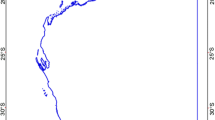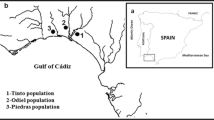Summary
Seed and transplanted adult plants from populations of Festuca rubra, collected from inland, salt-marsh and sand-dune sites were grown on culture solution with added sodium chloride. The growth of the populations of the three habitats was reduced differentially by salt. The salt marsh ecotype Festuca rubra ssp. litoralis was only slightly affected and the inland ecotype F. rubra ssp. rubra was severely retarded at 60 mM NaCl. The dune ecotype F. rubra ssp. arenaria had an intermediate tolerance. The tolerant ecotypes accumulated less sodium chloride as compared to the sensitive ecotype, suggesting that salt tolerance is caused in part by salt exclusion.
In addition, the dune ecotype F.r. arenaria appeared to be more drought tolerant than the salt marsh ecotype. Abscission of salt-saturated leaves does not function as an adaptation to salinity in Festuca rubra.
All three ecotypes accumulated proline with increased salinity. The response was most pronounced in the drought tolerant F.r. arenaria, indicating that proline accumulation is a response to osmotic stress rather than to ion-specific effects of salinity. The observed differences in salt tolerance may be explained by differential sensitivity to toxic effects of sodium chloride.
The occurrence on a beach plain of closely adjacent populations of F.r. arenaria and F.r. litoralis, differing markedly in salt tolerance, is briefly discussed.
Similar content being viewed by others
References
Abbayes, H. des, Claustres, G., Corillion, R., Dupont, P.: Flore et végetation du Massif Armoricain. Saint Brieuc: Vicairie 1971
Abel, G.H.: Inheritance of the capacity for chloride inclusion and chloride exclusion by soy beans. Crop Sci. 9, 157–160 (1969)
Ahmad, I., Wainwright, S.J.: Ecotype differences in leaf surface properties of Agrostis stolonifera from salt marsh spray zone and inland habitats. New Phytol. 76, 361–366 (1976)
Albert, R.: Salt regulation in halophytes. Oecologia (Berl.) 21, 57–71 (1975)
Albert, R., Kinzel, H.: Unterscheidung von Physiotypen bei Halophyten des Neusiedlerseegebietes (Österreich). Z. Pflanzenphysiol. 70, 138–158 (1973)
Auquier, P.: Le problème de Festuca rubra L. subsp. arenaria (Osb). Richt. et de ses relations avec F. juncifolia St. Amans. Le Jeunia, nouv. ser. 57, 1–24 (1971)
Barbour, M.G.: Is any angiosperm an obligate halophyte? Am. Midl. Nat. 84, 105–120 (1970)
Beeftink, W.G.: De zoutvegetatie van Zuid-West-Nederland beschouwd in Europees verband. Thesis, Landbouw Hogeschool, Wageningen (1965)
Berg, C. van den: The influence of absorbed salts on growth and yield of agricultural crops on salty soils. Versl. Landbouwk. Onderzoek, 58.5, 's Gravenhage (1952)
Carrol, J.C.: Effects of drought, temperature and nitrogen on turf grasses. Plant Physiol. 18, 19–36 (1943)
Epstein, E.: Mineral nutrition of plants, principles and perspectives. New York: Wiley 1972
Ernst, W.H.O.: Schwermetallvegetation der Erde. Stuttgart: Fischer 1974
Flowers, T.J.: Halophytes. In: Ion transport in plant cells and tissues D.A. Baker, J.L. Hall, (eds.), pp. 309–334. Amsterdam: North-Holland 1975
Flowers, T.J., Troke, P.F., Yeo, A.R.: The mechanism of salt tolerance in halophytes. Ann. Rev. Plant. Physiol. 28, 89–121 (1977)
Freijsen, A.H.J.: Some observations on the transition zone between the xerosere and the halosere on the Boschplaat (Terschelling, The Netherlands) with special attention to Centaurium vulgare Rafn. Acta Bot. Neerl. 15, 668–682 (1967)
Freijsen, A.H.J.: Growth-physiology salt tolerance and mineral nutrition of Centaurium litorale (Turner) Gilmour: adaptation to its oligotrophic and brackish habitat. Acta Bot. Neerl. 20, 577–588 (1971)
Freijsen, A.H.J., van Dijk, A.: Differences in growth rate and salt tolerance between varieties of the halophyte Centaurium litorale and their ecological significance. Acta Bot. Neerl. 24, 7–22 (1975)
Freijsen, A.H.J., Heeres, E.: Welke soort rood zwenkgras (Festuca rubra s.l.) komt voor in de jonge kustduinen van Voorne en die van overig Nederland? Gorteria 6, 57–61 (1972)
Freijsen, A.H.J., van Heusden, H.T.A.: Festuca rubra op Terschelling. Gorteria 2, 154–158 (1965)
Greenway, H.: Salinity, plant growth and metabolism. J. Aust. Inst. Agric. Sci. 39, 24–34 (1973)
Hannon, N.J., Barber, H.N.: The mechanism of salt tolerance in naturally selected populations of grasses. Search 3, 259–260 (1972)
Hannon, N.J., Bradshaw, A.D.: Evolution of salt tolerance in two coexisting species of grass. Nature 220, 1342–1343 (1968)
Harberd, D.J.: Observations on population structure and longevity of Festuca rubra L. New Phytol. 60, 184–206 (1961)
Heukels, H., van Ooststroom, S.J.: Flora van Nederland. Groningen: Wolters-Noordhoff 1973
Hubac, C., Guerrier, D.: Etude de la composition en acides amines de deux Carex; Le Carex sténophylla Wahl. f. pachystylis (J. Gay) Asch. et Graebn. très résistant à la sécheresse et le Carex setifolia Godron non Kunze, peu résistant. Effet d'un apport proline exogène. Oecol. Plant. 7, 147–165 (1972)
Hunter, A.C.F.: Salt tolerance in Festuca rubra. Ph. D. Thesis, University of Stirling (1971)
Jennings, D.H.: Halophytes, succulence and sodium in plants, a unified theory. New Phytol. 67, 899–911 (1968)
Khan, A.H.: The physiology of salt tolerance in Festuca rubra L. Ph. D. Thesis, School of Plant Biology, Bangor (1972)
Kluge, M.: Carbon and nitrogen metabolism under water stress. In: Ecological studies, Vol. 19. Water and plant life (O.L. Lange, L. Kappen, E.-D. Schulze, eds.), pp. 243–252. Berlin-Heidelberg-New York: Springer 1976
Kylin, A., Quatrano, R.S.: Metabolic and biochemical aspects of salt tolerance. In: Ecological studies (A. Poljakoff-Mayber, J. Gale, eds.), pp. 147–167. Berlin-Heidelberg-New York: Springer 1975
Lange, O.L., Kappen, L., Schulze, E.D. (eds.): Water and plant life. Ecological studies, Vol. 19. Berlin-Heidelberg-New York: Springer 1976
Levitt, J.: Responses of plants to environmental stresses. New York: Academic Press 1972
Poljakoff-Mayber, A., Gale, J. (eds.). Plants in saline environments. Ecological studies, Vol. 15. Berlin-Heidelberg-New York: Springer 1975
Richards, L.A.: Diagnosis and improvement of saline and alkaline soils. Handbook U.S. Dept. Agric. 60 (1954)
Rozema, J.: The influence of salinity, inundation and temperature on the germination of some halophytes and non-halophytes. Oecol. Plant. 10, 317–329 (1975)
Rozema, J.: An eco-physiological study on the response to salt of four halophytic and glycophytic Juncus species. Flora 165, 197–209 (1976a)
Rozema, J.: Vegetation zonation at a beach plain at Schiermonnikoog [in Dutch]. Waddenbulletin 3, 144–148 (1976b)
Rozema, J.: Population dynamics and ecophysiological adaptations of some coastal Juncaceae and Gramineae. Proc. First European Ecological Symposium (1978, in press)
Rozema, J., Blom, B.: Effects of salinity and inundation on the growth of Agrostis stolonifera and Juncus gerardii. J. Ecol. 65, 213–222 (1977)
Rozema, J., Buizer, D.A.G., Fabritius, H.E.: Population dynamics of Glaux maritima and ecophysiological adaptations to salinity and inundation. Oikos (1978, in press)
Rozema, J., Nelissen, H.J.M., van der Kroft, M., Ernst, W.H.O.: Nitrogen mineralization in sandy salt marsh soils of the Netherlands. Z. Pflanzenern. Bodenk. 140, 707–717 (1977)
Schobert, B.: Is there an osmotic regulatory mechanism in algae and higher plants? J. Theor. Biol. 68, 17–26 (1977)
Stewart, G.R., Larher, F., Ahmad, I., Lee, J.A.: The role of nitrogen in the adaptation of plants and animals to a saline environment. Proc. First European Ecological Symposium (1978, in press)
Stewart, G.R., Lee, J.A.: The role of proline accumulation in halophytes. Planta (Berl.) 120, 279–289 (1974)
Tiku, B.L.. Snaydon, R.W.: Salinity tolerance within the grass species Agrostis stolonifera L. Plant Soil 35, 421–431 (1977)
Troll, W., Lindsley, J.: A photometric method for the determination of proline. J. Biol. Chem. 215, 655–660 (1955)
Waisel, Y.: Biology of halophytes. New York: Academic Press 1972
Walter, H.: Grundlagen der Pflanzenverbreitung. I. Teil: Standortslehre. Stuttgart: Ulmer 1960
Walter, H.: Vegetation der Erde, Bd. II. Die gemäßigten und arktischen Zonen. Jena: Fischer 1968
Author information
Authors and Affiliations
Rights and permissions
About this article
Cite this article
Rozema, J., Rozema-Dijst, E., Freijsen, A.H.J. et al. Population differentiation within Festuca rubra L. with regard to soil salinity and soil water. Oecologia 34, 329–341 (1978). https://doi.org/10.1007/BF00344910
Received:
Issue Date:
DOI: https://doi.org/10.1007/BF00344910




